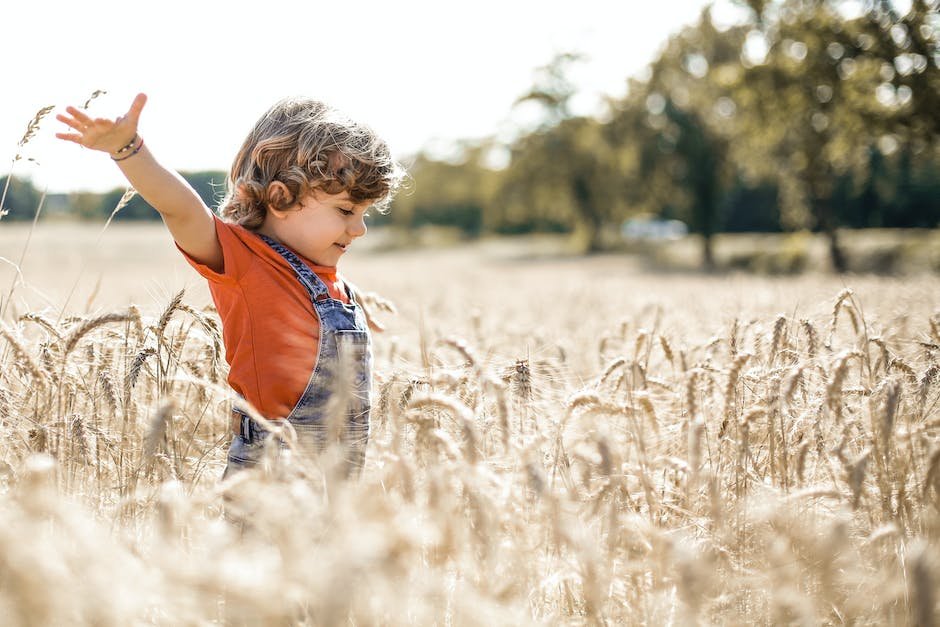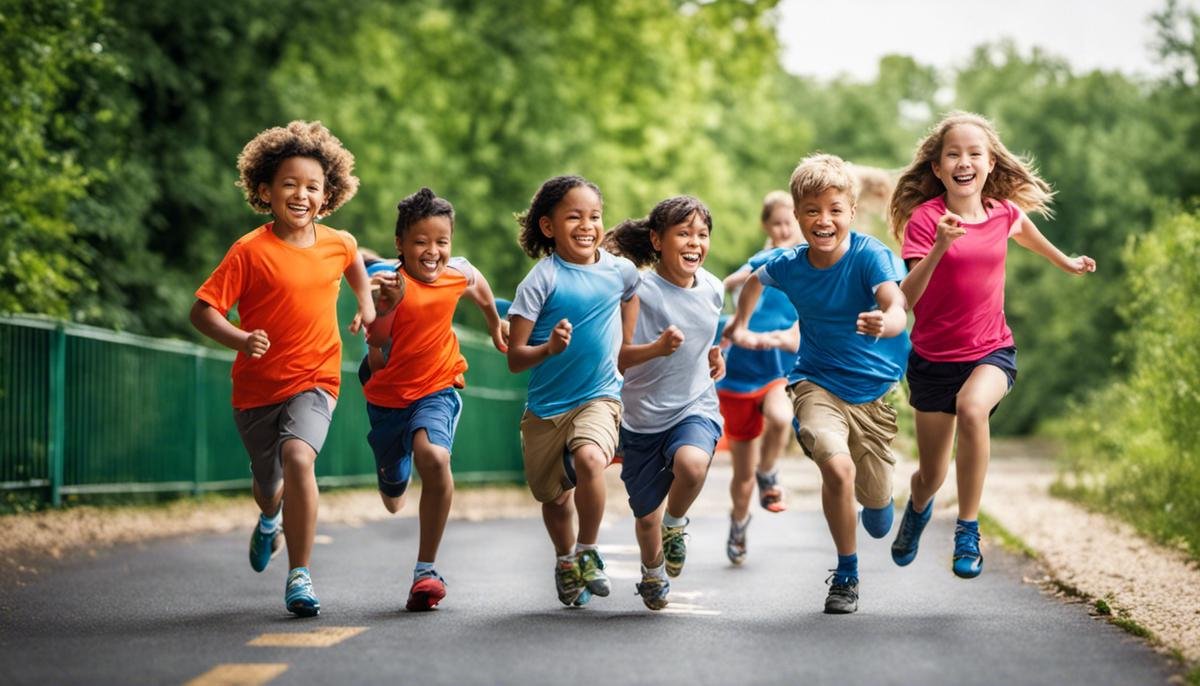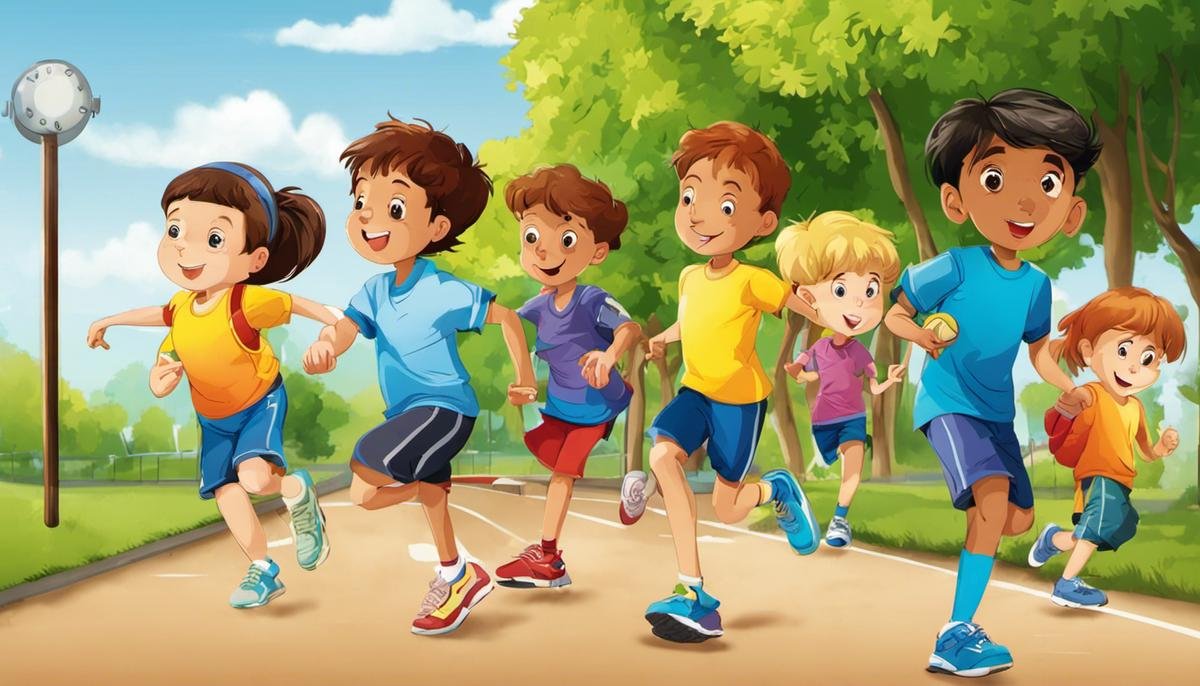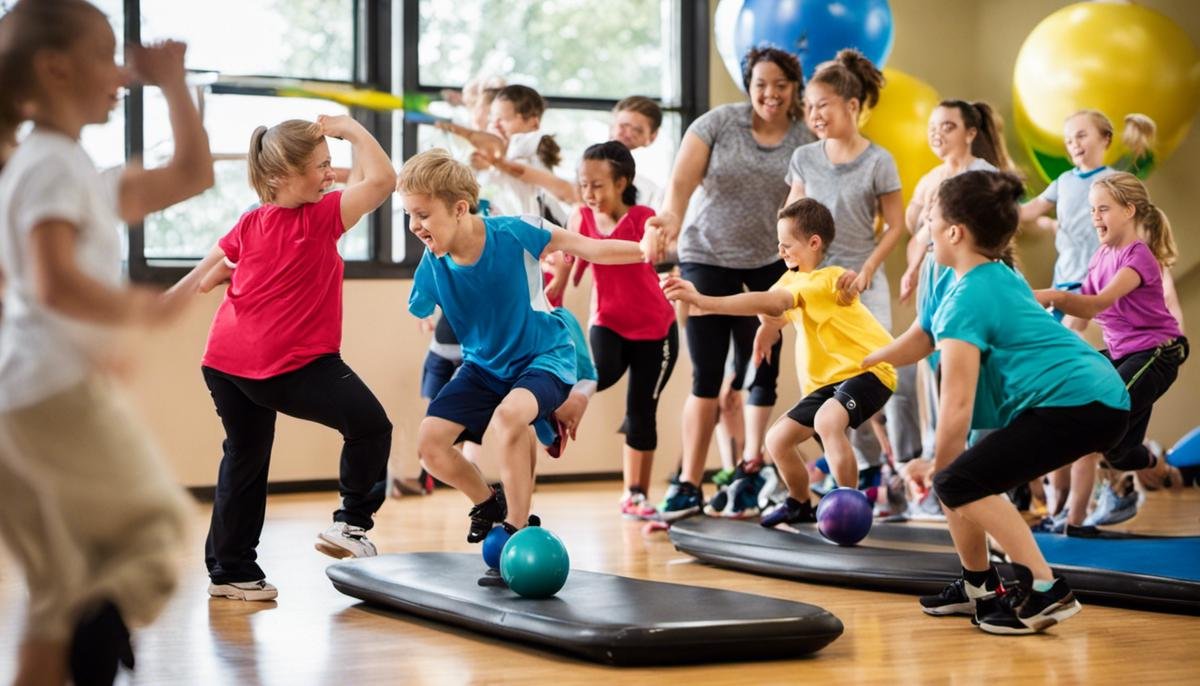
Enter into a world that hosts a unique blend of abilities; a world where standard norms are often recast. This is the world of individuals living with autism. Autism presents as a complex, multifaceted condition which significantly affects engagement in physical activities for those who live with it. Challenges stem from fundamental issues involving motor skills, coordination, and group participation that many take for granted. Additionally, with autism often comes a distinctive range of sensory processing issues. These may provoke either hypersensitivity or hyposensitivity to stimuli, adding another layer of complexity to physical involvement. We endeavor to extract these threads and make sense of the way they interweave, to provide an in-depth understanding of physical activity complications within the ambience of autism.
Understanding Autism and Physical Activity
Understanding Autism’s Effect on Physical Activity
Dearest moms, dads, and caregivers out there in this wonderful, collective world of parenting; let’s delve into a topic that is often shrouded in mystery and misconception: autism and its impact on physical activity. While it’s true that raising a child with autism presents unique challenges, we’re here to shed light on how autism can influence physical activity and why it holds tremendous importance.
Children on the autism spectrum, like all children, have an inherent need for movement and play. However, they frequently experience unique hurdles in the realm of physical activity. Whether it’s grappling with motor skills, struggling to grasp group dynamics or slashing through the sensory overload, the path to physical fitness for an autistic child can sometimes resemble a high-hurdle race.
Topping the list of these challenges is the issue of motor skills. It is widely understood that children with autism often have differing motor skill development compared to their peers. It’s not unusual for them to struggle with catching a ball, riding a bike, or even tying shoelaces. These difficulties might discourage them from participating in physical activities that other children their age might find easy-peasy-lemon-squeezy.
The societal aspect of physical activities might be another stumbling block. Group dynamics, understanding rules of a game, or picking up on sports-related social cues – it can all be a potential minefield for children on the spectrum.
Last but not least, sensory processing. Imagine being on an ever-spinning carousel, sight, sound, and sensations amplified. That’s the reality for a lot of kids with autism. Intense light, noise, or even the feel of certain fabrics can prove overwhelming, making the physical activity environment challenging to navigate.
Having shed light on the challenges, it’s essential to emphasize on the question: why is physical activity vital for children on the autism spectrum? It bears incredible benefits, that’s why! Regular exercise can alleviate common difficulties associated with autism, such as issues with sleep and anxiety. Structured physical activity can also improve motor skills, not to mention giving a significant boost to self-esteem.
Moreover, physical activities serve as an excellent platform to develop social competencies. By participating in structured group activities, children on the spectrum can learn essential social skills such as playing fair, waiting for their turn, and working effectively as part of a team.
To wrap it all up, it’s a challenge, indeed. Adjustments and adaptations are often necessary. However, the rewards are profoundly rich. From improving motor skills to honing social competencies, physical activity must be highly encouraged in the life of an autism-impacted child.
Remember, dear parent or caregiver, you’re not alone. This community stands with you, steadfast in support, in sharing, in understanding, and above all, in celebrating the uniqueness of our dearly loved little ones. In the face of adversity and triumph, we navigate this journey together, one brave step at a time.

Common Struggles with Physical Activity in Autism
Overcoming Physical Activity Hurdles for Children with Autism
While physical activity holds immense benefits, it can also pose unique challenges for children diagnosed with autism. Beyond the obstacles already discussed, such as motor skills difficulties, managing group dynamics and social cues, and the potential for sensory overload, several other factors come into play. Let’s discuss some of these hurdles and how, with a little patience and creativity, they can be successfully navigated.
Feeling safe and secure is vital for everyone, particularly children, but its importance is magnified for children with autism. Many autistic children find the unpredictable nature of sports and physical activities unsettling. This might manifest as a reluctance to participate or an inability to focus. To counter this, introducing structured and predictable routines related to the physical activity can immensely aid in creating a sense of security.
Another significant hurdle is the fear of being judged or ridiculed. Although this is an issue affecting many children, it’s often intensified for those with autism due to past experiences of being misunderstood or misjudged. Empathy from peers, supportive environment from physical education teachers, and family’s understanding, recognition, and acceptance can go a long way in eliminating such insecurities.
Communication challenges also often play a role in limiting the engagement of autistic children in physical activities. The assembly of verbal commands and visual cues that accompany these activities can be overwhelming. A great workaround here is to slow down, break down the tasks into smaller, easily understandable instructions, and use visual aids whenever possible.
An equally critical aspect is the physical contact involved in many sports. Autistic children might feel uncomfortable with the essential contact that comes with sports like basketball or soccer. Identifying sports that minimize close contact, such as swimming or running, can be a suitable alternative in such instances.
Lastly, autistic children may encounter difficulties in comprehending the concept of winning and losing. It can be challenging for them to make sense of the competitive aspect of team sports. By diverting the focus from the idea of competition to the joy of playing and being physically active, parents and teachers can help take the pressure off winning and losing.
While these challenges may seem overwhelming, remember that every child is different, and what works for one might not work for another. Consistency, patience, keeping things fun and engaging, and plenty of encouragement can go a long way in providing your child with the positive experiences and advantages that physical activity brings. Even with the challenges, the rewards for health, self-esteem, social skills, and overall well-being are well worth the effort. Always remember, as parents and caretakers, you are your child’s greatest advocate, support, and cheerleader!

Photo by jrlawrence on Unsplash
Benefits of Physical Activities for Autistic Children
The Crucial Role of Physical Activities for Children with Autism
Physical activities serve a pivotal role for all children in their development—stimulating growth, encouraging social interaction, and boosting mental wellbeing. For children with autism, engaging in such activities tends to bear a manifold of other substantial values. Building on our previous discussion about the importance of physical activities and the necessary adjustments needed for children with autism, this article continues to delve deeper into understanding why these activities are nothing less than essential.
In the area of cognitive development, studies show that regular physical activities can enhance the cognitive skills of children with autism. Swimming, running, or playing catch stimulates brain development by improving attention span, memory, and problem-solving skills. Physical activity even directly impacts academic performance—providing an effective way to improve focus and concentration in the classroom.
Also crucial is the effect of physical activity on reducing challenging behavior. Physical activities offer an outlet for pent up energy, which can otherwise often translate into tantrums or repetitive behaviors. An energetic run in the park or a fast-paced swim session can help channel this energy positively, lowering restlessness to create a calmer, peaceful home environment.
Speaking of restful environments, regular physical activity helps improve sleep patterns among children with autism. The physically engaged body tends to fall asleep quicker and experiences deeper, uninterrupted sleep—a significant benefit given that sleep issues are often prevalent amongst autistic children.
A less acknowledged, but an equally important aspect is the role of physical activities in developing resilience to life’s disappointices. Engaging in team sports where both winning and losing are part and parcel of the game teaches children the value of dealing with successes and failures. Naturally, an understanding and sensitive approach to discussing these topics with autistic children is necessary, but navigating these conversations paves the way to helping a child understand that it’s perfectly okay not to win every time.
Finally, physical activity encourages a healthy body image and a positive sense of self-worth. As children become more confident in their abilities, they form an improved perception of their bodies leading to enhanced self-esteem. This effect is a potent tool for combating feelings of isolation or inadequacy that they might wrestle with.
The undeniable importance of physical activities for children with autism deserves our utmost attention. Abilities vary among these children, as they do among all children, but each one has the capacity to engage, benefit, and shine. With a bit of patience, loads of love, and the right accommodations, let’s join hands and pledge to provide all our children with the opportunities they deserve to thrive, grow, and lead fulfilling lives.

Strategies and Solutions for Overcoming Challenges
When considering strategizing to help children with Autism Spectrum Disorder (ASD) engage more in physical activity, there are a range of methods that parents and caregivers can utilize to create a successful environment. These strategies not only foster more interaction with physical activities but also inculcate a love for these activities.
Foremost among these strategies is creating personalized and individualized physical activities. Children with autism vary drastically in terms of personal preferences, interests, and sensory sensitivities, which means what works for one child may not work for another. Identifying what specific movements, activities, or games a child enjoys is the key to success. Start with an activity your child enjoys and then slowly expand to other areas with positive reinforcements.
Whilst doing so, it’s imperative to maintain a routine. Many autistic children thrive on predictability. Hence, incorporating the identified physical activities into a regular timetable helps increase familiarity and reduces anxiety. Consistency is key. Adapt to the child’s pace, never rush them, and ensure a steady routine to let them warm up to the activities.
Moreover, the inclusion of sensory-friendly equipment can make a significant difference. As sensory issues can make physical activity overwhelming or even intimidating for an autistic child, choosing the right equipment can be the game changer. Soft-textured tools, quiet environments, individual playing space, or even dimmed lights can contribute to making physical activities more attractive to children with autism.
Autism-friendly classes or groups provide another excellent strategy. These classes are usually characterized by their smaller group sizes, specifically trained instructors, and adaptability towards sensory and social needs. They provide an understanding environment where children feel comfortable to participate, make friends, and learn at their own pace.
Additionally, incorporating technology can be a beneficial strategy. Apps that encourage movement in a fun and stimulating way can create excitement about getting active. Video games that require actual physical movement are modern gadgets that help in driving motivation. Don’t shy away from using such technology to your advantage.
One can also use creative outlets like dance and music as part of the strategy. These are fun ways to promote physical activity without the pressure of traditional “sports.” Autistic children often have a strong affinity towards music, and combining it with physical movement can produce great results.
Last but not least, one of the most effective strategies is parental or caregiver involvement. Joining your child in physical activities demonstrates your support, helps them feel more comfortable trying new things, and can make activities more enjoyable.
Remember, it’s about having patience, giving lots of encouragement, and allowing the child with ASD to move at a pace comfortable for them. Each child is unique, so strategies that may work for one might not work for the other. Rather than focusing on the challenges, concentrate on their individual abilities, preferences, and potential. Eclectic approaches and fine-tuning strategies will gradually result in the child favoring physical activities more. What matters the most is that the child feels loved, safe, and is having fun while being active.

Success Stories and Final Thoughts
Boosting Confidence and Achieving Success in Physical Activities for Children with Autism
Every child is unique, possessing their individual personality, talents, and skills. Children with autism are no different; they just need a unique approach to discover and nurture their strengths. Incorporating physical activity into a child’s routine can often be challenging. Still, many success stories remind us of the many benefits physical activity can provide, particularly to children with Autism Spectrum Disorder (ASD).
Several parents and professionals have found immense success in modifying conventional physical activities. These success stories serve as an inspiration to parents seeking fresh ways to meet the physical activity challenges in autism.
There’s Jenny’s story about her son, Ethan. Ethan has always shown a keen interest in swimming, but his sensory overload made him hesitant to take the plunge. Jenny didn’t let this dampen their spirits. Instead, she sought an instructor who held ASD-specific classes, where the pools were quieter it was less crowded. The instructor used sensory-friendly equipment such as weighted blankets and uniquely designed floaties that provided a safer and more controlled environment for Ethan. Under this custom and patient coaching, Ethan not only learned to swim but now proudly flaunts his medals from Autism Swim competitions.
There’s also Emma, an ASD professional who works with a local school. She successfully introduced and integrated a variety of physical activities from dance to yoga within the education system. The activities she incorporated catered specifically to the individual needs of each child. She also used technology creatively to engage students, using applications and video games which facilitated movement and increased their interest in participating. Now, her once resistant students eagerly anticipate their daily physical activity session.
Music and dance have also proven to be powerful tools for motivating and engaging children with autism. Jack’s mom Cindy, shared her son’s triumph in a contemporary dance performance. With a love for rhythm all his own, Jack’s dance teacher, noticing his potential, worked to create a routine that suited his individual abilities. In performing before an audience, Jack not only discovered a newfound passion for dance but also gained enormous self-esteem.
These success stories underscore the importance of persistence and patience. They are wonderful reminders that children with autism, given the right motivation, can overcome physical activity challenges, harnessing them to improve their motor skills, sleep patterns, social interaction, and overall well-being.
Moreover, these stories serve as an inspiration to other parents, caregivers, and professionals. They remind us that everyone can enjoy and benefit from physical activity, sometimes you just need the right approach. So, whether it’s an autistic-child-friendly class, using technology creatively, focusing on music and dance, or patient, compassionate instruction – there is a unique solution for every child.
Let these stories uplift us as we continue to strive to connect with, and support our children, enabling them to meet challenges, and most importantly, to excel at them. Remember, every little step counts, it’s about progress, not perfection.

We have traveled a comprehensive journey, exploring the intricacies of autism and its correlation with physical activity. Amidst the challenges and struggles, we found glimmers of hope and achievement. The stories of autistic children overcoming their difficulties to accomplish personal physical activity goals are not just tales of triumph, but serve as inspiration for others embarking on a similar path. With patience, consistent effort, and tailored strategies, barriers can and do crumble. What unfolds is a broader horizon, filled with improved physical health, cognitive functioning, and social skills. As we conclude this insightful journey, remember that perseverance is key and every small step forward is a big leap towards success. The arena of physical activity, albeit challenging, holds a sea of opportunities for children with autism. Embrace the unexplored paths; they often lead to beautiful destinations.




